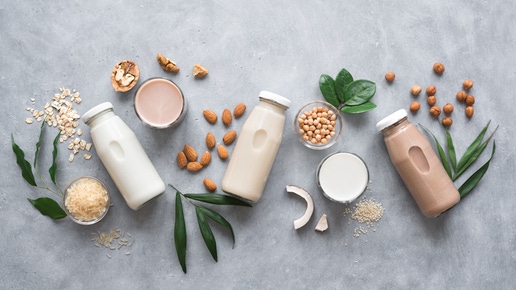
7 Dietitian tips for feeding kids on a budget
Raising kids means keeping up with their endless appetites. Whether they're adventurous eaters or picky nibblers, finding a balance of healthy, delicious and budget-friendly meals that please everyone can be quite the juggling act, especially with today's cost of living pressures.
We spoke to Accredited Practising Dietitian and parent of two Teri Lichtenstein for her top tips on how to get the best possible nutrition into kids when the purse strings are tight.
Teri’s first piece of advice? Ease the pressure on yourself and accept that sometimes you just can’t manage it all. “Remember that a healthy diet isn’t made up from one meal or one day,” she said. “It’s what we do most of the time that matters.”
So, with that guiding advice in mind, here are seven tips from Teri to guide your weekly menu planning:
1. Prioritise plant protein
Focus on using more plant-based proteins like legumes, beans, seeds and nuts to fill your kids up. They offer many health benefits, and are less expensive than animal proteins. An international study of 150 countries estimated that diets including less animal protein were up to 29% less expensive than diets relying on animal protein.
For family-friendly meal inspiration that includes plant-based proteins, use the huge catalogue of simple and affordable recipes Sanitarium has created.
2. Fuel with wholegrain fibre
Fibre is essential for maintaining digestive health, regulating blood sugar levels and promoting a feeling of fullness. Wholegrains are an easy and affordable way to tick this box and having a lower glycaemic index compared to more processed grains, they release energy more slowly, which is great to sustain kids between meals.
Bread is a great place to start to get more wholegrains in the family diet. Look for other affordable wholegrain swaps like using wholegrain spaghetti when a recipe calls for more expensive and less nutritious noodles.
Wholegrain breakfast cereals are another great swap. Simple wholegrain wheat biscuits or oats are a great example of good value nutrition to start the day well.
3. Think in colour
Canned and frozen fruit and veggies can be used widely as cheap and delicious pantry staples that can help you more easily meet your daily nutrition goals and veggie intake. And they can be just as nutritious as the fresh stuff.
Take it one step further and think in colour – rather than specific produce – when you are planning meals and doing your shop. For example, if your recipe calls for kale, but it’s not in season or it’s expensive, look for a cheaper leafy green alternative and use that instead.
4. Find your hero
Before you do the grocery shop look in your fridge and pantry to see what needs to be used up, then build your meals around it. This might be excess veggies at the bottom of the fridge or leftover cooked rice that just needs some frozen vegetables and protein to turn it into a tasty fried rice.
You can also make the most of imperfect fruit and vegetables and visit fresh produce markets at the end of their operating week for cheap and bulk deals, and then build your meal around it.
5. Storage is key
Throwing away less food will not only help the planet but will save you money too. Australians waste 7.6 million tonnes of food each year, costing households a whopping $36.6 billion!
Food lasts longer when stored correctly. Remove fresh produce such as baby cucumbers, carrots and salad leaves from their plastic packaging and store them in containers to prevent them from going soggy. Lining the containers with paper towel will help absorb excess moisture to prevent food spoiling.
It’s also important to understand the difference between date labels. ‘Use-by’ dates are about safety, which means you shouldn’t eat food past the date whereas ‘best before dates’ are about quality – meaning the food is often still safe to eat after the date shown.
If you aren’t likely to finish a product by its use-by, store the rest of it in the freezer for later. For products past their best before, think of other ways to use them like yoghurt in a marinade or dressing.
6. Plan, plan, plan
Cooking at home saves money, and meal planning is your best friend when it comes to creating budget-friendly family meals. Most supermarket catalogues are released on Mondays, so try planning your meals around the weekly sales.
Create a flexible shopping list that allows you to swap ingredients based on what is most cost effective. Prioritise versatile ingredients like carrots, potatoes, tofu, rice, tinned legumes and frozen veggies and get creative with using every part of the produce, like stir-frying cauliflower leaves or making carrot top pesto.
7. Brush up on cooking skills
Cooking skills are essential life skills that help you save money and take control of your family’s health. You don’t need to be a pro chef but having the skills to tasty-up your meals with simple things like olive oil, garlic, lemon juice and herbs can help you avoid buying expensive sauces.
If you’re new to cooking and feeling a little intimidated, start by asking friends for their foolproof recipes or invite an experienced friend over for a cooking session. The more time you spend in the kitchen, the more confident you’ll become. In the meantime, check out these recipe collections to help get you started: Budget-friendly recipes or Easy 30 minute meals.
Make the most of discounted introductory meal kit offers that will provide you with ingredients and simple instructions for preparing. And you can always try a simple meal assembly method – grab some frozen veggies, wholemeal spaghetti, rice and tofu and voila, you have a stir-fry.
For more expert tips on making healthy eating more affordable visit our Eat Well for Less hub.

The latest nutrition advice, plus health and wellness tips delivered to your inbox monthly

